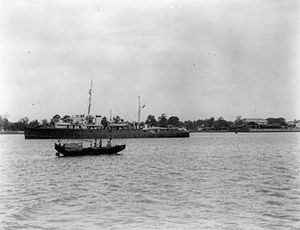HMIS Indus (U67)
 Indus in Akyab harbour, Burma, 1942
| |
| History | |
|---|---|
| Name | Indus |
| Namesake | Indus |
| Builder | Hawthorn Leslie and Company |
| Laid down | 8 December 1933[1] |
| Launched | 24 August 1934[1] |
| Commissioned | 15 March 1935[1] |
| Identification | Pennant number: L67 (U67 after 1940) |
| Fate | Sunk by Japanese aircraft off Akyab, 6 April 1942 |
| General characteristics [2] | |
| Class and type | Grimsby class sloop |
| Displacement | 1,190 long tons (1,210 t) standard load |
| Length | 296 ft 4 in (90.32 m) oa |
| Beam | 35 ft 6 in (10.82 m) |
| Draught | 10 ft 9 in (3.28 m) |
| Propulsion |
|
| Speed | 16.25 kn (30.10 km/h; 18.70 mph) |
| Complement | 119 |
| Armament |
|
HMIS Indus was a Grimsby-class sloop of the Royal Indian Navy launched in 1934 and sunk during the Second World War in 1942. She was a slightly enlarged version of other vessels in the Grimsby class. She was named after the Indus River. Indus served mainly as an escort vessel, and she was therefore lightly armed. Her pennant number was changed to U67 in 1940.[3]
History
[edit]Indus was a part of the Eastern Fleet during the war.
In March 1942, British Indian Army and British Army troops from Rangoon had to be withdrawn, as they were overwhelmed by the superior numbers as well as the air command of the Japanese. Akyab was the next port to be attacked by the Japanese in April. The Flag-Officer-Commanding of the Eastern Fleet refused to withdraw Indus and Sutlej from the anti-infiltration patrol off Akyab. On 6 April, Indus suffered 3 direct bomb hits in an air raid by Japanese Mitsubishi G3M bombers, and sank in 35 minutes. There was no loss of life to her crew although 10 were injured.[4][5]
Fate
[edit]On 6 April 1942 Indus was bombed and sunk by Japanese aircraft off Akyab, Burma in position 20°7′N 92°54′E / 20.117°N 92.900°E
Commanding officers
[edit]Indus commanding officers during her service were:
- Commander Eric George Guilding (24 November 1938 – 23 September 1941)
- Lieutenant Commander Jesser Evelyn Napier (23 September 1941 – 6 April 1942) - promoted to commander on 25 October 1941
- Commander James Wilfred Jefford
See also
[edit]Notes
[edit]- ^ a b c d Hague 1993, p. 60.
- ^ Campbell 1980, p. 56.
- ^ HMIS Indus (L 67 / U 67) at uboat.net.
- ^ "REPORT OF PROCEEDINGS (ROP) OF EASTERN FLEET - 1942". naval-history.net. 14 July 2011. Retrieved 23 December 2012.
- ^ Shores, Cull and Izawa, 1993, p. 405.
References
[edit]- Campbell, N. J. M. (1980). "Great Britain (including Empire Forces)". In Chesneau, Roger (ed.). Conway's All the World's Fighting Ships 1922–1946. Greenwich, UK: Conway Maritime Press. pp. 2–85. ISBN 0-85177-146-7.
- Colledge, J. J.; Warlow, Ben & Bush, Steve (2020). Ships of the Royal Navy: The Complete Record of all Fighting Ships of the Royal Navy from the 15th Century to the Present (5th revised and updated ed.). Barnsley, UK: Seaforth Publishing. ISBN 978-1-5267-9327-0.
- Collins, J.T.E. (1964). The Royal Indian Navy, 1939–1945. Official History of the Indian Armed Forces In the Second World War. New Delhi: Combined Inter-Services Historical Section (India & Pakistan).
- Hague, Arnold (1993). Sloops: A History of the 71 Sloops Built in Britain and Australia for the British, Australian and Indian Navies 1926–1946. Kendal, UK: World Ship Society. ISBN 0-905617-67-3.
- Lenton, H. T. (1998). British & Empire Warships of the Second World War. Annapolis, Maryland: Naval Institute Press. ISBN 1-55750-048-7.
- Rohwer, Jürgen (2005). Chronology of the War at Sea 1939–1945: The Naval History of World War Two (Third Revised ed.). Annapolis, Maryland: Naval Institute Press. ISBN 1-59114-119-2.
- Shores, Christopher; Cull, Brian; Izawa, Yasuho (1993). Bloody Shambles: Volume Two: The Defence of Sumatra to the Fall of Burma. London: Grub Street. ISBN 0-948817-67-4.

